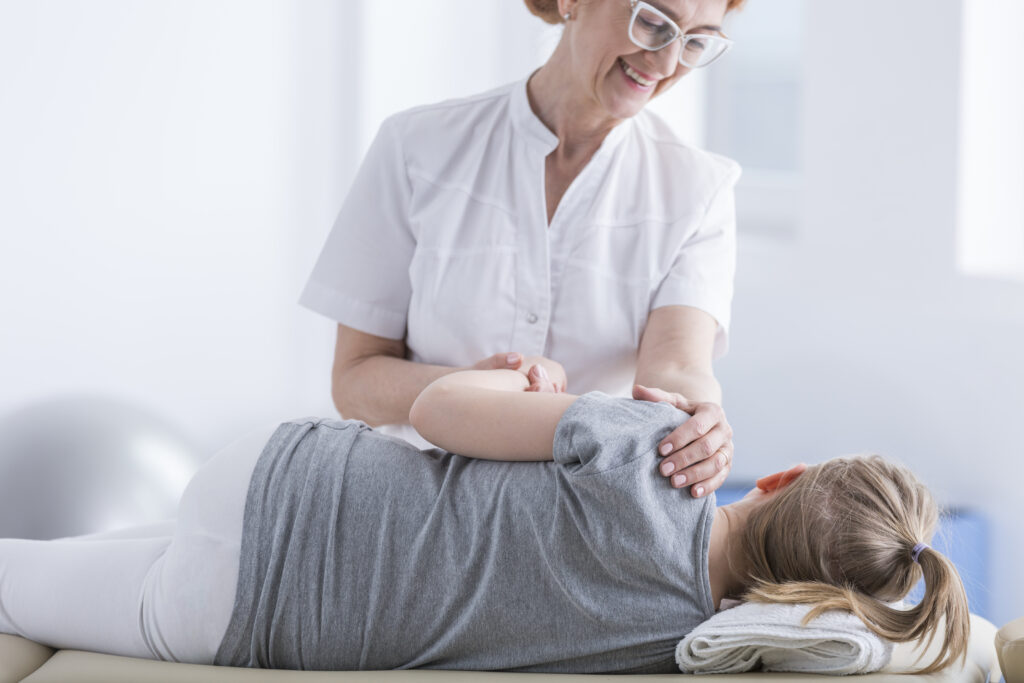Scoliosis is a common spinal condition affecting millions of adolescents. One of the conventional approaches to managing scoliosis is the use of a brace, designed to halt the progression of spinal curvature. However, for many young patients, the emotional and physical challenges associated with wearing a scoliosis brace can be daunting. Read about the journey of a patient who dropped scoliosis brace and chose exercise treatment, shedding light on the reasons behind this decision and the transformative impact it had on her life.
Why I Dropped Scoliosis Brace: A Year and a Half of Uncomfortable Restriction
Before our patient discovered the alternative of exercise treatment, she was subjected to the rigid embrace of a scoliosis brace for approximately a year and a half, beginning in her sixth-grade years. The prescribed wear time for the brace was from 6:30 in the morning to 7:30 in the evening, effectively making it an integral part of her daily life. This constant reminder of her condition posed both physical and emotional challenges.
Emotional Impact
For this girl, donning the scoliosis brace to school was a daily ordeal. It set her apart from her peers, and its conspicuous presence made her self-conscious. Simple tasks like bending down to pick up a fallen pencil became a source of embarrassment, as the contours of the brace were visible under her clothing, inviting inquisitive gazes and uncomfortable questions. The emotional toll was substantial, chipping away at her self-esteem and self-worth.
Sports and Physical Activities Hindered
The impact of the brace extended beyond emotional distress to significantly hampering her participation in physical activities, particularly her passion for sports. With the brace restraining her movements, her athletic pursuits were severely restricted, leading to a sense of frustration and the need to relinquish her cherished activities.
The Quest for a Better Solution
As the limitations and challenges of wearing a brace became increasingly evident, our patient’s family embarked on a quest to explore alternative scoliosis management options. The decision to transition from bracing was precipitated by her father’s online research, which uncovered the Hudson Valley Scoliosis System. Encouraged by the numerous positive reviews and testimonials, they decided to embrace this novel approach, primarily because they believed there were no other viable alternatives left, having even received recommendations for surgery.
Exercise Treatment: A Proactive Approach
The transition to exercise treatment marked a turning point in her scoliosis journey. This approach emphasized two core principles: consistency and commitment. Daily exercises formed the cornerstone of the treatment plan, gradually reshaping her spine and contributing to significant improvements in her condition.
Results and Transformation
The results yielded by exercise treatment were nothing short of remarkable. Her upper spinal curve underwent substantial reduction, accompanied by an overall enhancement in her posture. These physical improvements translated into a newfound sense of freedom and agility, qualities she had sorely missed during her brace-wearing days. The transformation extended beyond the physical realm, significantly enhancing her emotional well-being and self-confidence.
The Role of Parental Support
Throughout this transformative journey, the unwavering support of her parents played an invaluable role. They were the driving force behind the decision to transition to exercise treatment. Emphasizing the importance of daily commitment and the efficacy of the chosen path, her parents provided the necessary reassurance and motivation. Their steadfast belief in this treatment modality helped her stay focused and dedicated to her daily exercise regimen.
Recommendations for Parents
If our patient had the opportunity to address parents currently grappling with the decision between scoliosis bracing and exercise treatment for their adolescent daughters, she would wholeheartedly advocate for the latter. The visible and tangible positive results she experienced serve as a compelling testimony. In contrast, bracing represents a path filled with uncertainty, where success is far from guaranteed. Exercise treatment offers a proactive and effective strategy, capable of bringing about profound improvements in the lives of young scoliosis patients. The message is clear: scoliosis does not have to define your child’s life, and exercise treatment can open the door to a brighter, more active future.
Conclusion
The journey of this girl transitioning from scoliosis bracing to exercise treatment has been nothing short of life-changing. The emotional and physical burdens associated with the brace were undeniable, compelling her to seek a better solution. Exercise treatment not only improved her scoliosis but also rekindled her self-confidence and sense of freedom. It is a non-invasive and convenient option, and she wholeheartedly encourages parents and young patients to consider it as their first choice. Scoliosis should not hold young people back, and exercise treatment can be the key to a brighter and more active future.
Also read: 30 Years Scoliosis Pain Relieved with 1 Week of Treatment
About:
Dr. Strauss is the director of the Hudson Valley Scoliosis Correction Center in New York. He has been actively engaged in scoliosis treatment for the past 30 years and has authored two books on the subject, Your Child Has Scoliosis and The Truth About Adult Scoliosis.
He is Vice President of the CLEAR Scoliosis Institute and a lecturer for their introductory and advanced workshops. He is certified in scoliosis bracing and in the use of scoliosis specific exercises. Dr. Strauss is a graduate of the ISICO World Masters of Scoliosis.His postgraduate studies also include a Masters Degree in Acupuncture as well as training in Grostic, Pettibon, CBP, Clinical Nutrition, Chinese Herbal Medicine, Manipulation under Anesthesia, and Electrodiagnosis.
His scoliosis practice has treated patients from 25 states and 32 other foreign countries.If you have questions about childhood and adult scoliosis and how it can be successfully treated without surgery subscribe to our channel!
